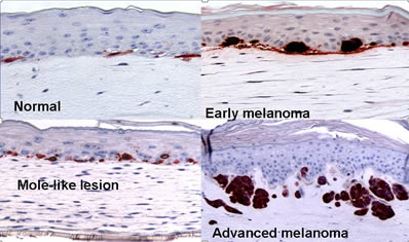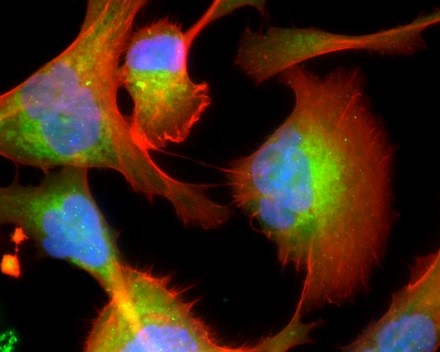Patient Derived Tumor Models
Tumor modelling facilitates the study of tumor growth in the tumor microenvironment. Therapies that affect the tumor microenvironment are critical for advancing the fight against cancer as emerging therapies target the network of signaling pathways essential for tumor growth and metastasis. Patient derived tumor models, including melanoma cell lines and tumor xenografts, are invaluable tools to study normal and malignant cells, tumor formation and drug resistance.
A diverse panel of melanoma cell lines, now available from Rockland Immunochemicals, is required to account for the varied genetic signatures of tumors, especially if the scientific goal is to establish drug sensitivity for tumor inhibition, therapy resistance, or tumor dormancy. Tumor xenografts are available from Rockland produced on a custom basis in murine models
Featured Melanoma Cell Lines grouped by Gene Mutations
Melanoma Cell Lines with Mutated BRAF
Melanoma Cell Lines with Mutated N-RAS
Melanoma Cell Lines with Mutated KIT
Melanoma Cell Lines with Mutated PTEN
Melanoma Cell Lines with Mutated CDK4
For any further information on these Cell Lines, please contact us at Info@2BScientific.com
Rockland Immunochemicals Inc. has partnered with the Wistar Research Institute, to produce, validate and distribute a diverse panel of low passage melanoma cell lines from freshly excised metastases. More than 100 melanoma cell lines are grouped for BRAF, N-RAS, KIT, PTEN and CDK4 mutations. These preclinical tumor cell lines models can be used to identify the critical target genes and pathways enacted by genomic alterations and lead to more accurately prediction of the effectiveness of novel cancer therapeutics and facilitate cancer research.
Introduction
The cellular and molecular heterogeneity of human cancers is well established. Different tumor cells can show distinct phenotypic and molecular characteristics of the original cancer, including chromosomal copy number variants, single nucleotide polymorphisms, and gene expression profiles. This heterogeneity has clinical implications in patient specific responses to therapy and represents a substantial challenge for cancer drug development.
With the advent of precision medicine, i.e. explicit, targeted tumor therapies, it has become important to ascertain tumor subpopulations which respond to anti-cancer therapy. In this milieu, the tumor models that more accurately reflect patient tumor biology and provide the resolution necessary to represent the diversity of cancer patients, are required for testing novel anti-cancer compounds.
Read more

Figure 1. Development of melanoma cell lines. After a low number of cell passages, cells are banked and validated by extensive analysis including copy number determination, gene expression profiling, immunohistochemical staining with antibodies to known tumor biomarkers, STR and response to drugs.
Melanoma Cell Lines
We produce, validate and distribute a diverse collection of highly characterized melanoma cell line models. These models have the ability to predict clinical activity as they are biologically stable in terms of gene expression pattern, tumor architecture and mutation status. These melanoma cell lines serve as individualized experimental models, important for drug treatment and outcome.
This collection, originally provided by Dr. Meenhard Herlyn of The Wistar Institute, has been characterized to confirm a match to that of the originating patient tumor tissue via mRNA, qPCR and DNA short tandem repeat (STR) analysis. In addition to viable cells, Rockland produces non-viable cells for lysate production, genomic DNA, and total RNA from each melanoma cell line.

Figure 2. Modeling melanoma in sythentic skin. Image courtesy of Dr. Meenard Herlyn, Wistar Institute, Philadelphia, PA
Melanoma Cell Lines with Specific Gene Mutations
Malignant melanoma is associated with genetic heterogeneity and a complex etiology. In contrast to other skin cancers, melanoma has a strong tendency to metastasize with a consequently extremely poor overall prognosis for survival. The various phenotypes of melanoma are characterized by clinical features, such as bodily distribution or risk factors.
Cutaneous, uveal, acral, and mucosal melanomas have divergent clinical courses and are associated with distinct mutations, and risk factors. In the majority of melanomas, a number of genes and signaling pathways are involved in cellular proliferation and growth, and have been implicated in the pathophysiology of melanoma.
We have organized our collection of melanoma cell lines based on the presence and/or absence of mutated or wild type genes. At a minimum we have characterized these cell lines for the following genes: BRAF, N-RAS, KIT, PTEN and CDK4.

Figure 3. The melanoma microenvironment. Image courtesy of Dr. Meenard Herlyn, Wistar Institute, Philadelphia, PA.
